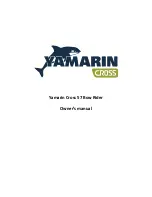
4127 • 42 Super Sport 4/06
11
BOATING SAFETY
SECTION 1
Garbage
Dumping garbage into the sea is a worldwide problem. U.S. Coast Guard
regulations prohibit dumping plastic refuse and garbage mixed with plastic into
any waters, and restrict the dumping of other forms of garbage. It is essential
that all boaters help to clean our waterways by properly disposing of all garbage.
Within three miles of the shore of U.S. lakes, rivers and bays it is illegal to dump
plastic, dunnage, lining and packing materials that float, and any garbage except
dishwater/greywater or fresh fish parts. From three to twelve miles from shore it
is illegal to dump plastic, dunnage, lining and packing materials that float, and
any garbage not ground to less than one square inch. From 12 to 25 miles from
shore it is illegal to dump plastic, dunnage, lining and packing materials that
float. Beyond 25 miles from shore it is illegal to dump plastics.
Oil
The Federal Water Pollution Control Act prohibits the discharge of oil or oily
waste into or upon the navigable waters and contiguous zone of the United
States if such discharge causes a film or sheen upon, or discoloration of, the
surface of the water, or causes a sludge or emulsion beneath the surface of the
water. Violators are subject to a significant fine.
Septic Waste
On U.S. inland and coastal waters, it is illegal to discharge septic waste directly
overboard. If your boat is equipped with an overboard discharge option, check
with your local U.S. Coast Guard office to be sure that you are in compliance
with federal regulations.
State and Local Ordinances
Your state or locality may have laws limiting speed, noise, or your boat’s wake.
Check with your harbor master to find out whether your boat’s operation is
restricted in any way by local ordinances or state laws. Check with state and
local authorities to make sure that you are in compliance with local regulations
regarding marine sanitation, noise, speed and wake.
Pre-Departure Actions
• Check the weather. Make sure conditions and seas will not be hazardous
during your voyage.
• Make sure all safety equipment is onboard, accessible and in good
working condition.
• Check the bilge for fuel vapor or water. Ventilate or pump out the bilge
as necessary.
• Be sure the horn, navigation equipment and lights are working properly.
• Instruct guests and crew in safety and operational matters.
• Check engine and transmission oil and coolant levels. After starting the
engines, check the overboard flow of cooling water, engine temperatures and
oil pressures.
• Fill fuel tanks as full as you need. Know your tank capacity and fuel
consumption at various RPMs and the cruising radius this gives you. When
estimating your range, it is best to count on using ⅓ of your fuel to reach
your destination and ⅓ of your fuel to return, with the remaining ⅓ of your
fuel in reserve for emergencies.
• Have a second person onboard capable of taking over the boat’s operation in
case you are disabled.
Summary of Contents for 42 SUPER SPORT
Page 1: ...HIN CDR _________________ 42 Super Sport Owner s Guide 2006 Version 1...
Page 2: ......
Page 4: ......
Page 6: ......
Page 8: ......
Page 28: ......
Page 64: ......
Page 94: ......
Page 118: ......
Page 132: ......
Page 140: ...128 4127 42 Super Sport 4 06 WARRANTY AND PARTS SECTION 9 Bill of Material...
Page 141: ...4127 42 Super Sport 4 06 129 WARRANTY AND PARTS SECTION 9 Carver Limited Warranty...
















































